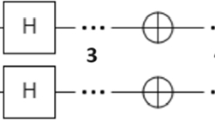Abstract
The significance of combinatorial optimization for many important applications is well understood. The simulated annealing algorithm (which we will denote from here on as SA) has generated great interest and attention in the scientific community. Its authors derived it from analogies to the physical domain [15,10], and a myriad of publications followed (see references to the book on simulated annealing in [11]). The prevailing opinion expressed in these publications was that the SA algorithm represents a new, hitherto unknown class of algorithms and provides a breakthrough in the solution of NP-hard optimization problems. As might be expected, roots of the SA do exist, and one of the purposes of this paper is to trace these roots. We prove that SA, like many other randomized algorithms, belongs to the class of S-type GH-stochastic automata. We provide other representatives of this class together with algorithms from some other classes, and discuss the issue of convergence. Large computational experiemts were performed on a network of Apollo computers.
Similar content being viewed by others
References
E. Aarts and P. van Laarhoven, Statistical cooling: A general approach to combinatorial optimization problems, Phillips J. of Res. 40(1985)193–226.
S. Anily and A. Federgruen, Simulated annealing methods with general acceptance probabilities, J. Appl. Prob. 24(1987)657–677.
R. Bush and F. Mosteller,Stochastic Models for Learning (Wiley, New York, 1958).
P.J. Cameron, M. Deza and D. Frank, Intersection theorems in permutation groups, Combinatorica 8, 3(1988)249–260.
G. Cohen and M. Deza, Some metrical problems onS n , Ann. Discr. Math. 8(1980)211–219.
W. Feller,An Introduction to Probability Theory and Applications, Vol. 1 (Wiley, New York, 1950).
B. Gidas, Nonstationary Markov chains and convergence of the annealing algorithm, J. Statis. Phys. 39(1985)73–131.
D.L. Isaacson and R.W. Madsen,Markov Chains Theory and Applications (Wiley, New York, 1976).
D. Johnson, C. Aragon, L. McGeoch and C. Schevon, Optimization by simulated annealing: Experimental evaluation (part 1), Preprint.
S. Kirkpatrick, C.D. Gelatt, Jr. and M.P. Vecchi, Optimization by simulated annealing, Science 220(1983)671–680.
P.J.M. van Laarhoven and E.H.L. Aarts,Simulated Annealing: Theory and Applications (Reidel, Dordrecht, 1987).
S. Lakshmivarahan and M. Thathachar, Absolutely expedient learning algorithms for stochastic automata, IEEE Trans. on Systems, Man, and Cybernetics SMC-3(1973)281–286.
R. McLaren, A stochastic automation model for synthesis of learning systems, IEEE Trans. Syst. Sci. Cybern. SSC-2(1966)109–144.
G. McMurthy and K. Fu, A variable structure automation used as a multinodal search technique, IEEE Trans. Automat. Contr. AC-11(1966)379–387.
N. Metropolis, A. Rosenbluth, M. Rosenbluth, A. Teller and E. Teller, Equation of state calculations by fast computing machines, J. Chem. Phys. 21(1953)1087–1092.
D. Mitra, F. Romeo and A. Sangiovanni-Vincentelli, Convergence and finite time behavior of simulated annealing, J. Adv. Appl. Prob. 18(1986)741–771.
S. Nahar, S. Sahni and E. Shragowitz, Experiments with simulated annealing,Proc. 22nd Des. Automation Conf., Las Vegas (1985) pp. 748–752.
S. Nahar, S. Sahni and E. Shragowitz, Simulated annealing and combinatorial optimization,Proc. 23rd Des. Automation Conf., Las Vegas (1986) pp. 293–299.
K. Narendra and M. Thathachar, Learning automata — A survey, IEEE Trans. on Systems, Man, and Cybernetics SMC-4(1974)323–334.
S. Reiter and G. Sherman, Discrete optimizing, J. Soc. Indust. Appl. Math. 13(1965)864–889.
S. Reiter and D. Rice, Discrete optimizing solution procedures for linear and nonlinear integer programming problems, Manag. Sci. 11(1966)829–850.
F. Romeo and A. Sangiovanni-Vincentelli, Probabilistic hill-climbing algorithms: Properties and applications, Report No. UCB/ERL M84/34, Electronics Research Laboratory, University of California (1984).
I. Sergienko and M. Kaspschitzkaya,Models and Methods for Solving Combinatorial Problems on Computers (Naukova Dumka, Kiev, 1981).
I. Shapiro and K. Narendra, Use of stochastic automata for parameter self-optimization with multinodal performance criteria, IEEE Trans. Syst. Sci. Cybern. SSC-5, 4(1969)352–360.
B. Trakhtenbrot and Y. Barzdin,Finite Automata, Behavior and Synthesis (North-Holland, Amsterdam, 1973).
M. Tsetlin, On the behavior of finite automata in random media, Automatika i Telemechanika 22, 10(1961)1345–1354.
M. Tsetlin,Automation Theory and Modeling of Biological Systems (Nauka, Moscow, 1969).
M. Tsetlin,Automation Theory and Modeling of Biological Systems (Academic Press, New York, 1973). English edition.
Y. Tzypkin and A. Poznyak, Learning automata, J. Cybern. Inf. Sci. ASC 1, 2–4(1977)128–160.
V. Varshavskii and I. Vorontsova, On the behavior of stochastic automata with a variable structure, Automatika i Telemechanika 24, 3(1963)353–360.
V. Varshavskii,Collective Behavior of Automata (Nauka, Moscow, 1973).
I. Vorontsova, Algorithms for changing stochastic automata transition probabilities, Problemi Peredachi Informatzii 1, 3(1965)122–126.
Author information
Authors and Affiliations
Rights and permissions
About this article
Cite this article
Shragowitz, E., Lin, RB. Combinatorial optimization by stochastic automata. Ann Oper Res 22, 293–324 (1990). https://doi.org/10.1007/BF02023058
Issue Date:
DOI: https://doi.org/10.1007/BF02023058




